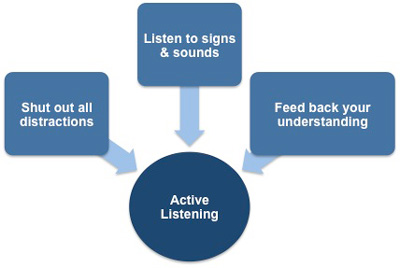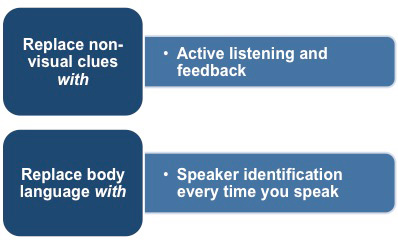Adapting Your Communication Style
The reason that most people prefer to meet others in person is because so much interpersonal communication depends on non-verbal cues. When you are in the same room as the other meeting participants it is very easy for you to see the extent to which others understand what you are saying.
You can also tell at a glance if others agree with you, need clarification or have something of their own to contribute. These visual and physical clues are what you use to help you gauge an individual's response to what you have said or done. These clues form a key element in your initial judgment of any new person you meet, without which you will feel less able to make such as assessment and may be a reason you avoid conference calls.
This problem of real-time communication without accompanying visual cues is not new and dates back to the invention of the telephone. Even though cheap phone calls have been around for fifty years, they have never succeeded in entirely supplanting one-on-one meetings. This is because most people prefer to 'get to know' others face-to-face. This fact, plus anecdotal evidence suggests most of us are not entirely happy to hold important discussions without the added input of non-verbal communication.
This suggests that by 'getting to know' someone first, you can then feel more confident in making inferences about their level of engagement, interest and understanding from their voice alone. This is supported by the fact that most people feel as though it is more mentally demanding to hold a complex conversation with someone by telephone than it is to do so face-to-face.
Active Listening
By using this technique you can enhance your effectiveness during conference calls. By developing your skills of actively listening you will be able to compensate for the lack of visual feedback with an increased audio feedback. This is how you will ensure that you have picked up in the true meaning of what someone has said. You will also retain a greater percentage of what is said during the call, no longer will you only remember about half of what was said.
 |
You can hearing examples of this during a telephone conversation when both parties check the other's understanding every few seconds by using a combination of verbal ticks that encourage confirmation (like 'yeah?', 'OK?', 'You know what I mean?', etc). You will also hear them make use of slight pauses that allow the opportunity for interjection.
At the other end of the conversation you know the other person is likely to be making some verbal indication that they have heard your message, whether in agreement or not. This can take many forms, such as, 'mmmm', 'Yeah' 'Ok', 'Right'. 'I see', 'Really?' etc.
By making sure you incorporate your active listening skills into your teleconference calls you will ensure that you cut out pointless distractions and you will be able to make certain compensations for lack of visual feedback with your increased audio. This enables you to improve your understanding and demonstrate this during the conversation.
Even when one person is dominating the conversation, what is happening is very much a two-way process with almost constant requests for feedback from the person talking. If you doubt this, then try saying nothing at all the next time someone is talking to you on the phone. After about ten seconds, there will usually be a short pause before they say something like 'Are you still there?' or they make it obvious that they do not feel as though you are paying attention.
 |
The problem with conference calls is that they do not allow for this continuous feedback and the person doing the talking often feels uncomfortable, without being able to say why this is the case. This is particularly true when conference call attendees use the 'mute' facility on their phone. Whilst this does prevent distracting environmental noise, it leaves the presenter feeling as though they are speaking into a void.
This lack of ongoing auditory feedback is very similar to VHF radio communication where the underlying technology only allows one party to speak at a time. In order to cope with this limitation, VHF radio operators are trained to communicate in a very formulaic way that can sound faintly ridiculous to outsiders.
This involves each participant in the conversation identifying themselves every time they speak, as well as keeping each statement as short and as straightforward as possible. Far from being an affectation, this protocol has been refined over many years to eliminate misunderstandings as much as possible.
Whilst no-one would seriously suggest that conference calling needs to adopt protocols as strict as those used by VHF operators, there is a need to be aware that conference calls are more challenging than a normal phone call between two people.
In fact, conference calls are one of the most often cited pet hates of employees who find that their motivation to participate and provide ideas are shut down by the impersonal and difficult to coordinate nature of the medium.
You may also be interested in:An Introduction to Conference Calls, Types of Conference Call, Technical Issues Affecting Conference Calls, Human Factor Issues, Maintaining Your Productivity, Adapting Your Communication Style, Advance Planning, Controlling the Call and Conference Call Etiquette.



